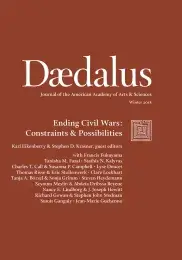In Defense of Ambition: Building Peaceful & Inclusive Societies in a World on Fire
Fragility creates the conditions for violent intrastate conflict. Its consequences contribute to global disorder and mounting threats to U.S. national security. Significant impediments to effective action in fragile states persist today, even with many years of policy attention and an emerging consensus about its centrality in causing armed conflict. Policy-makers across the U.S. interagency have yet to arrive at a shared consciousness about the challenge of fragility, a shared understanding of the nature of the problem, and the types of capacities that can be comprehensively deployed to address it effectively. This essay describes recent advances in the development sector with regard to fragile states that suggest a way forward for stronger results. The steep challenges of tackling the complex causes of fragility tell us to be measured in our actions, but the experiences of recent progress and the urgency to alleviate human suffering tell us the time is right for greater ambition.
In the wake of the two world wars, the world experienced significant progress: an increase in the number of democratic states, heartening advances toward eliminating global poverty, and significant decreases in violent conflict. But those positive trends have abruptly reversed in the last decade. Now, a new wave of civil wars, historic levels of migrants and refugees, global pandemics, and increases in violent extremism are fueling a sense of global disorder.
One critical cause for this increase in civil wars and violence can be traced to the challenges of fragile states. Several decades of scholarship and experience have identified the strong correlation between state fragility and higher levels of violent conflict, extreme poverty, violent extremism, and vulnerability to the predations of regional and international powers. In an increasingly interconnected world, fragility poses a greater threat to national and international security than ever before. It also presents pressing moral challenges. However, we have yet to effectively organize either the collective resources of the U.S. government or international institutions to address this challenge.
Doing so within U.S. government institutions will require a significant shift in the way U.S. defense, diplomatic, and development capabilities operate, moving away from deeply stovepiped bureaucracies that work without a shared framework to what General Stanley McChrystal has called a “shared consciousness” that enables more cohesive joint action.1 This means moving from vertical structures that inhibit effective action on complex, interrelated challenges to horizontal approaches that can more nimbly work to prevent the crises associated with states in which the state-society relationship has become dangerously frayed. As noted by Jean-Marie Guéhenno, in the search for effective means to prevent and end civil wars, “intelligent orchestration is the most important strategic variable, and … isolated policies, even well-executed ones, are unlikely to produce lasting results unless they are part of an overall coherent and consistent strategy.”2
Promising approaches for addressing fragility have emerged from the development sector, which is grappling with how to prevent significant investments from being overturned by repeated shocks from conflict and disaster. Development is arguably undergoing a paradigm shift, moving from narrowly focused investments designed to spur economic growth and isolated, sector-based programming, to a more systemic approach of managing risk and building resilience to the effects of disaster and conflict. However, unless development, diplomatic, and defense approaches align more consistently to adopt a shared understanding of how to address fragility, development efforts alone will not be successful.
. . .
